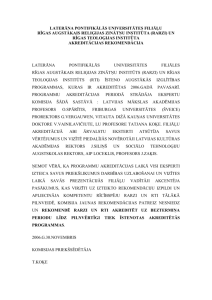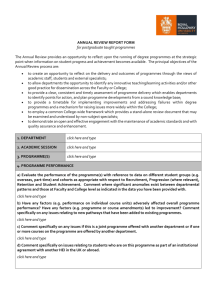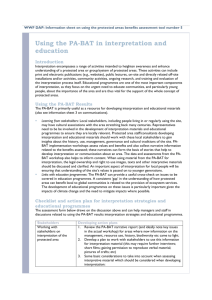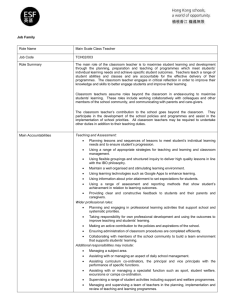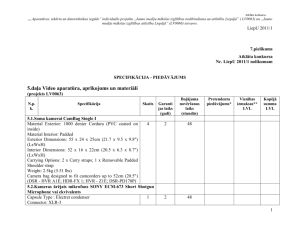RarziKZ06
advertisement
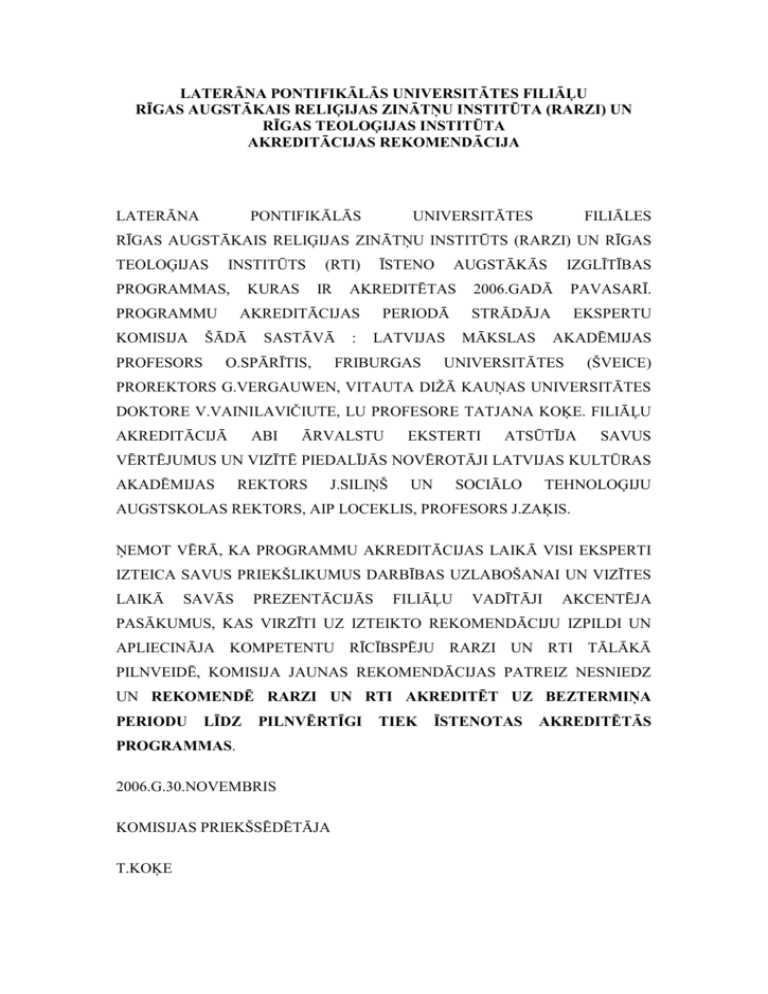
LATERĀNA PONTIFIKĀLĀS UNIVERSITĀTES FILIĀĻU RĪGAS AUGSTĀKAIS RELIĢIJAS ZINĀTŅU INSTITŪTA (RARZI) UN RĪGAS TEOLOĢIJAS INSTITŪTA AKREDITĀCIJAS REKOMENDĀCIJA LATERĀNA PONTIFIKĀLĀS UNIVERSITĀTES FILIĀLES RĪGAS AUGSTĀKAIS RELIĢIJAS ZINĀTŅU INSTITŪTS (RARZI) UN RĪGAS TEOLOĢIJAS INSTITŪTS PROGRAMMAS, PROGRAMMU KOMISIJA KURAS ĪSTENO SASTĀVĀ O.SPĀRĪTIS, AUGSTĀKĀS AKREDITĒTAS IR AKREDITĀCIJAS ŠĀDĀ PROFESORS (RTI) : PERIODĀ LATVIJAS FRIBURGAS IZGLĪTĪBAS 2006.GADĀ PAVASARĪ. STRĀDĀJA EKSPERTU MĀKSLAS AKADĒMIJAS UNIVERSITĀTES (ŠVEICE) PROREKTORS G.VERGAUWEN, VITAUTA DIŽĀ KAUŅAS UNIVERSITĀTES DOKTORE V.VAINILAVIČIUTE, LU PROFESORE TATJANA KOĶE. FILIĀĻU AKREDITĀCIJĀ ABI ĀRVALSTU EKSTERTI ATSŪTĪJA SAVUS VĒRTĒJUMUS UN VIZĪTĒ PIEDALĪJĀS NOVĒROTĀJI LATVIJAS KULTŪRAS AKADĒMIJAS REKTORS J.SILIŅŠ UN SOCIĀLO TEHNOLOĢIJU AUGSTSKOLAS REKTORS, AIP LOCEKLIS, PROFESORS J.ZAĶIS. ŅEMOT VĒRĀ, KA PROGRAMMU AKREDITĀCIJAS LAIKĀ VISI EKSPERTI IZTEICA SAVUS PRIEKŠLIKUMUS DARBĪBAS UZLABOŠANAI UN VIZĪTES LAIKĀ SAVĀS PREZENTĀCIJĀS FILIĀĻU VADĪTĀJI AKCENTĒJA PASĀKUMUS, KAS VIRZĪTI UZ IZTEIKTO REKOMENDĀCIJU IZPILDI UN APLIECINĀJA KOMPETENTU RĪCĪBSPĒJU RARZI UN RTI TĀLĀKĀ PILNVEIDĒ, KOMISIJA JAUNAS REKOMENDĀCIJAS PATREIZ NESNIEDZ UN REKOMENDĒ RARZI UN RTI AKREDITĒT UZ BEZTERMIŅA PERIODU LĪDZ PILNVĒRTĪGI PROGRAMMAS. 2006.G.30.NOVEMBRIS KOMISIJAS PRIEKŠSĒDĒTĀJA T.KOĶE TIEK ĪSTENOTAS AKREDITĒTĀS II Izglītības iestādes - RARZI vērtēšanas kritēriji (5 galvenie kvalitātes aspekti un 12 jautājumi) I Izglītības iestādes mērķi un uzdevumi. 1. Izglītības iestādes mērķu un uzdevumu skaidrība, sasniedzamība, saistība ar nacionālajiem uzdevumiem, zinātnes prasībām, izglītības iestādes akadēmiskā personāla mērķiem un uzdevumiem, studējošo interesēm un vajadzībām. Novērtējums: 4 Komentārs: Izglītības iestādes formulētais mērķis nozīmīgs sabiedrības un indivīda kontekstā. II Studiju organizācija un vadība. Novērtējums:3. Komentārs: ......... 2. Studiju, atpūtas un sadzīves apstākļi, kas nodrošina visiem studiju pretendentiem vienādu imatrikulācijas sistēmu; palīdzība un konsultācijas studentiem, studēšanas motivācija; iespējas apgūt zināšanas un prasmes ārpus studiju programmas. Novērtējums: 3 Komentārs: Vadība demonstrē rūpes par apstākļu uzlabojumiem. Ir paredzēta jauna korpusa celtniecība. 3. Studentu zinātniskās pētniecības darbība kā mācību procesa sastāvdaļa ; studentu zinātniskās biedrības; studentu zinātnisko darbu konkursi, apbalvojumi, prēmijas, speciālās stipendijas. Novērtējums: 3 Komentārs: Kopš programmu akreditācijas, mācībspēki aktivizējušies studentu iesaistē zinātniskajā pētniecībā. Taču joma kopumā ir aktivizējama. 4. Starptautiskā sadarbība, apmaiņas programmu un vieslektoru izmantošana; akadēmiskā personāla un studentu apmaiņas ar citām izglītības iestādēm; studentu prakses iespējas Latvijā un ārzemēs. Novērtējums:3. Komentārs: Ciešākā sadarbība ir ar Laterāna Pontifikālo universitāti Romā. Taču pēdējā laikā parakstītas nodomu vienošanās ar Viļņas Pedagoģisko universitāti (Lietuvā) un Meriveilas institūtu (Lielbritānijā). III Akadēmiskais personāls. Novērtējums: 4. Komentārs: ......... 5. Izglītības iestādes akadēmiskā personāla kvalifikācijas atbilstība tiesību aktos noteiktajām prasībām. Novērtējums: 4 Komentārs: Atbilst. 6. Zinātniskā darba tematikas aktualitāte; zinātniskā darba koordinācija un sadarbība ar zinātniskajām institūcijām Latvijā un ārvalstīs; izglītības iestādes zinātnisko darbinieku iesaistīšana mācību procesā. Novērtējums: 3 Komentārs: Pēdējā gadā akadēmiskais personāls ir aktivizējies zinātniskā darba īstenošanā, organizējot konferences un izdodot rakstu krājumus. IV Izglītības iestādes darbības vadība un nodrošinājums Novērtējums: 3 Komentārs: ......... 7. Izglītības iestādes autonomijas un demokrātijas principu realizācija, studentu iesaistīšana izglītības iestādes dzīves organizēšanā, akadēmiskā personāla darba kvalitātes iekšējā kontroles sistēma, izglītības iestādes personāla - akadēmiskā un vispārējā ievēlēšanas, atjaunināšanas un kvalifikācijas celšanas sistēma. Novērtējums: 3 Komentārs: ......... 8. Augstākās izglītības realizācijas prasībām atbilstīgas informācijas sistēmas, kā arī materiāltehniskais nodrošinājums un nodrošinājums ar kvalificētu apkalpojošo personālu. Novērtējums: 2 Komentārs: Būtiski pilnveidojams materiāli tehniskais nodrošinājums, kas varētu kalpot arī studentu piesaistei. 9. Izglītības iestādes uzdevumu izpildīšanai un ilgtermiņa attīstības plānu īstenošanai nepieciešamo finansiālo līdzekļu esamība. Novērtējums: 3 Komentārs: Attīstības mērķi formulēti skaidri, iespējams tos varētu tik detalizēti nesadrumstalot ( kopā 11 mērķi). Pārsvarā to īstenošanai tiek paredzēts finansējums no ārvalstu katoļu fondu piesaistītajiem līdzekļiem. V Kvalitātes nodrošināšana. Novērtējums: 4 Komentārs: ......... 10. Kvalitātes pilnveidošanas sistēmas nepārtraukta darbība, ilgtermiņa attīstības plānu regulāra veidošana un apspriešana. Novērtējums: 3 Komentārs: Pastāv ilgtermiņa attīstības plāns, kurā precīzāk nepieciešams izdalīt prioritātes un to sasniegšanas rīcības programmu pa gadiem. 11. Izglītības iestādes absolventu perspektīvas darba tirgū. Novērtējums: 4 Komentārs: Absolventi ir pieprasīti un atsauksmes ļoti labas. 12. Studiju turpināšanas iespējas un finansiālās garantijas studiju programmu likvidācijas, reorganizācijas vai citu izmaiņu gadījumā. Novērtējums: 4 Komentārs: Pastāv nepieciešamās vienošanās REKOMENDĀCIJA Akreditēt RARZI bez termiņa. Ekspertu komisijas vadītāja Profesore Tatjana Koķe III Augstākās izglītības iestādes filiāles – RARZI vērtēšanas kritēriji (6 jautājumi) 1. Filiāles darbības atbilstība Latvijas likumdošanai. Dokumentācijas par filiāli pieejamība: 1) politikas un mērķu formulējums, 2) pārvaldes struktūras apraksts, 3) konkrētu programmu, kursu un citu izglītības pakalpojumu mērķu un satura apraksti. Izklāsta skaidrība par filiāles un attiecīgās augstākās izglītības iestādes atbildību. Augstākās izglītības iestādes kontrole un pārraudzība par informācija, ko publisko tās filiāle. Juridiski saistošu dokumentu esamība, kuros skaidri noteikta augstākās izglītības iestādes un filiāles loma, atbildība, deleģētās darbības pilnvaras, kā arī pārraudzības kārtība. Novērtējums: 4 Komentārs: RARZI kā Laterāna Pontifikālās universitātes filiāles dokumentācija ir precīza un sniedz pilnīgu informāciju. 2. Akadēmiskās kvalitātes un standartu filiālē atbilstība : 1) kopējām prasībām augstākās izglītības iestādē; 2) prasībām analoģiskās programmās un augstākās izglītības iestādēs Latvijā. Studiju kvalitātes filiālē nodrošināšanas mehānismu skaidrība. Novērtējums: 4 Komentārs: Akadēmiskās kvalitātes standarti ir augsti un skaidri demonstrēta tendence pēc uzlabojumiem. Salīdzinājumu grūti veikt augstskolas specializācijas, kā arī individuālās pieejas dēļ. 3. Akadēmiskā personāla, kas māca filiālē, kvalifikācijas, pasniegšanas, zinātniskās darbības un cita veida profesionālās pieredzes atbilstība Latvijā noteiktajām prasībām. Augstākās izglītības iestādes organizētās kontroles efektivitāte par tā personāla kompetenci, kas pasniedz filiālē. Novērtējums: 3 Komentārs: Filiālei nepārtraukti jārūpējas par akadēmiskā personāla zinātniskās izaugsmes iespējām. 4. Augstākās izglītības iestādes atbildība par kvalifikācijām (grādiem, diplomiem, profesionālajām kvalifikācijām), kuras tā piešķir pēc studijām savā filiālē. Informācijas skaidrība un caurredzamība par piešķirtajām kvalifikācijām, izmantojot Eiropas vienoto Diploma Pielikumu. Informācijas par studiju programmas, kuras apgūšanas rezultātā tiek iegūtas kvalifikācijas, raksturu, ilgumu, studiju slodzi, programmas darbības vietu un valodu (-ām) esamība Diploma Pielikumā. Novērtējums: 4. Komentārs: Tiek demonstrēta rūpe un augsta atbildība par piešķiramajām kvalifikācijām. 5. Uzņemšanas prasību, studiju aktivitāšu, eksaminācijas un novērtēšanas prasību filiālē atbilstība tām, kas raksturīgas attiecīgajai augstākās izglītības iestādei. Norādījumu skaidrība programmu aprakstos par tikai filiālei specifiskajām izmaiņām studiju programmā. Novērtējums:4 Komentārs: Prasības formulētas skaidri un ir pieejamas studentiem.. 6. Akadēmiskās studiju slodzes atbilstība attiecīgajā programmā pašā augstākās izglītības iestādē. Atšķirību pamatotība un atspoguļojuma skaidrība filiālē realizējamās studiju programmas aprakstā. Novērtējums: 4. Komentārs: Precīzi formulētas un pamatotas programmu atšķirības Laterāna Pontifikālā universitātē Romā un filiālē Rīgā. Ekspertu komisijas priekšlikums akreditēt RARZI bez termiņa. Ekspertu komisijas priekšsēdētāja T.Koķe Profesore, dr.habil.paed. Questionnaire for Evaluation Commission Experts (Supplement to the individual report) It is recommended to evaluate each of aspects listed below by a mark according to the following scale and to add a short comment. In case of negative evaluation (mark 1) the comment is compulsory. It is recommended to add short description about each quality aspect: strengths, weaknesses, opportunities and threats. It is possible to leave without mark a question, about which expert is not competent. The filled in questionnaire expert must add to the reports – individual and joint. This questionnaire can also be used as a plan for the evaluation report. The scale for the assessment: 4 (excellent), 3 (highly satisfactory), 2 (satisfactory), 1(unsatisfactory) The assessment of higher education institution (5 main aspects and 12 questions) I Aims and objectives 1. Possibility to understand and to reach the aims and objectives defined by the higher education institution. The connection between those aims and objectives with national aims and objectives, with requirements of science, with aims and objectives of the academic staff of the institution and with interests and needs of the students. Assessment: ……3… Comment: ……… II The organization and management of studies Assessment: ……3… Comment: ……… 2. The conditions for studies, leisure and living conditions of the students ensuring a system of immatriculation equal for all candidates, guidance and counselling for students, motivation to study, opportunities to acquire knowledge and skills not foreseen by the study programme. Assessment: ……3… Comment: ……… 3. Research done by students as a part of the teaching process, student research associations, competitions of student research work, awards, prizes, special scholarships. Assessment: ……2… Comment: ……… 4. International cooperation, exchange programmes, inviting visiting lecturers, exchange of staff members and students with other higher education institutions, possibilities for the practical placements of students in Latvia and abroad. Assessment: ……3… Comment: ……… III Academic staff Assessment: …4…… Comment: ……… 5. Adequate qualification of the academic staff and its compliance with the requirements of legal norms (the amount of teaching done by teachers with doctor and habilitated doctor scientific degrees (at least 30 % at higher education institutions , 50 % at universities). Assessment: …4…… Comment: ……… 6. The up to date character of the research area, coordination of the research and cooperation with other research institutions in Latvia and abroad. The involvement of the research staff of the higher education institutions in the teaching process. Assessment: …4…… Comment: ……… IV The management of the higher education institution and provision with materials, informational and financial resources Assessment: ……3… Comment: ……… 7. Implementation of the principles of autonomy and democracy at the institution, the rights and duties of the students concerning the academic process at the institution. Internal quality control, the system of election and of upgrading academic and general staff of the institution. Assessment: ……3… Comment: ……… 8. Informational systems and opportunities for exchange of information in national and international networks, laboratories available that allow students to become familiar with modern technologies, employment of qualified auxiliary staff. Assessment: ……3… Comment: ………. 9. Availability of necessary financial resources to implement the objectives of the institution and its long-term development plan. Assessment: ……4… Comment: ……… V Quality assessment Assessment: ……4… Comment: ……… 10. The continuous action of the quality assessment and improvement system in the higher education institution, creation and discussion on the long term development plans. Assessment: ……4… Comment: ……… 11. The opportunities for the graduates on the labour market. Assessment: ……4… Comment: ……… 12. The opportunities to continue studies and financial guarantees in the case of a closure, a re-organization or other changes of the study programmes. Assessment: ……4… Comment: ……… III The criteria for the assessment of the branch of higher education institution and its study programmes (6 questions ) The scale for the assessment: 4 (excellent), 3 (highly satisfactory), 2 (satisfactory), 1(unsatisfactory) 1. Compliance of the activities of the branch with the national legislation of Latvia. Availability of the documentation concerning the branch: 1) the policy and the mission statement, 2) management structures, 3) the goals, objectives and contents of specific programmes, sets of courses of study, and other educational services. Existence and transparency of legally binding agreements or contracts setting out the rights and obligations of higher education institution and its branch. Control and monitoring by higher education institution of the information made public by its branch. Assessment: …4…… Comment: ……… 2. Comparability of the academic quality and standards of education programmes: 1) to those of the awarding higher education institution, 2) to those of the similar study programmes and higher education institutions in Latvia. Transparency of the procedures and decisions concerning the quality of educational services provided by the branch. Assessment: ……4… Comment: ……… 3. Proficiency of the staff members teaching on the programmes established in the branch in terms of qualifications, teaching, research and other professional experience. Effectiveness of the measures organized by the higher education institution to review the proficiency of staff, delivering programmes in the branch. Assessment: …4… Comment: ……… 4. Responsibility of the higher education institution for issuing the qualifications resulting from its study programmes in the branch. Transparency of the information on the qualifications, in particular through the use of the Diploma Supplement, facilitating the assessment of the qualifications by competent recognition bodies, the higher education institutions, employers and others. Inclusion of the information about the nature, duration, workload, location and language(s) of the study programme, leading to the qualifications, in the Diploma Supplement. Assessment: …4… Comment: ……… 5. Equivalence of the requirements of the admission of students for a course of study, the teaching/learning activities, the examination and assessment, provided in the branch, to those of the same or comparable programmes delivered by the awarding higher education institution. Existence of a clear indications of any difference in this respect between the branch and the awarding higher education institution. Assessment: ……4… Comment: ……… 6. Existence of a clear indications of any difference in the academic work load, duration of studies or otherwise between the branch and the awarding higher education institution, and a clear statement on the rationale of the differences. Assessment: ……4… Comment: ……… II The assessment of higher education institution (5 main aspects and 12 questions) I Aims and objectives 1. Possibility to understand and to reach the aims and objectives defined by the higher education institution. The connection between those aims and objectives with national aims and objectives, with requirements of science, with aims and objectives of the academic staff of the institution and with interests and needs of the students. Assessment: 4 II The organization and management of studies Assessment: 4 2. The conditions for studies, leisure and living conditions of the students ensuring a system of immatriculation equal for all candidates, guidance and counselling for students, motivation to study, opportunities to acquire knowledge and skills not foreseen by the study programme. Assessment: 4 3. Research done by students as a part of the teaching process, student research associations, competitions of student research work, awards, prizes, special scholarships. Assessment: 4 4. International cooperation, exchange programmes, inviting visiting lecturers, exchange of staff members and students with other higher education institutions, possibilities for the practical placements of students in Latvia and abroad. Assessment: 3 III Academic staff Assessment: 4 5. Adequate qualification of the academic staff and its compliance with the requirements of legal norms (the amount of teaching done by teachers with doctor and habilitated doctor scientific degrees (at least 30 % at higher education institutions , 50 % at universities). Assessment: 4 6. The up to date character of the research area, coordination of the research and cooperation with other research institutions in Latvia and abroad. The involvement of the research staff of the higher education institutions in the teaching process. Assessment: 3 IV The management of the higher education institution and provision with materials, informational and financial resources Assessment: 3 7. Implementation of the principles of autonomy and democracy at the institution, the rights and duties of the students concerning the academic process at the institution. Internal quality control, the system of election general staff of the institution. and of upgrading academic and Assessment: 3 8. Informational systems and opportunities for exchange of information in national and international networks, laboratories available that allow students to become familiar with modern technologies, employment of qualified auxiliary staff. Assessment: 4 9. Availability of necessary financial resources to implement the objectives of the institution and its long-term development plan. Assessment: 3 V Quality assessment Assessment: 3 10. The continuous action of the quality assessment and improvement system in the higher education institution, creation and discussion on the long term development plans. Assessment:4 11. The opportunities for the graduates on the labour market. Assessment: 3 12. The opportunities to continue studies and financial guarantees in the case of a closure, a re-organization or other changes of the study programmes. Assessment: 3 III The criteria for the assessment of the branch of higher education institution and its study programmes (6 questions ) The scale for the assessment: 4 (excellent), 3 (highly satisfactory), 2 (satisfactory), 1(unsatisfactory) 1. Compliance of the activities of the branch with the national legislation of Latvia. Availability of the documentation concerning the branch: 1) the policy and the mission statement, 2) management structures, 3) the goals, objectives and contents of specific programmes, sets of courses of study, and other educational services. Existence and transparency of legally binding agreements or contracts setting out the rights and obligations of higher education institution and its branch. Control and monitoring by higher education institution of the information made public by its branch. Assessment: 4 2. Comparability of the academic quality and standards of education programmes: 3) to those of the awarding higher education institution, 4) to those of the similar study programmes and higher education institutions in Latvia. Transparency of the procedures and decisions concerning the quality of educational services provided by the branch. Assessment: 4 3. Proficiency of the staff members teaching on the programmes established in the branch in terms of qualifications, teaching, research and other professional experience. Effectiveness of the measures organized by the higher education institution to review the proficiency of staff, delivering programmes in the branch. Assessment: 4 4. Responsibility of the higher education institution for issuing the qualifications resulting from its study programmes in the branch. Transparency of the information on the qualifications, in particular through the use of the Diploma Supplement, facilitating the assessment of the qualifications by competent recognition bodies, the higher education institutions, employers and others. Inclusion of the information about the nature, duration, workload, location and language(s) of the study programme, leading to the qualifications, in the Diploma Supplement. Assessment: 3 5. Equivalence of the requirements of the admission of students for a course of study, the teaching/learning activities, the examination and assessment, provided in the branch, to those of the same or comparable programmes delivered by the awarding higher education institution. Existence of a clear indications of any difference in this respect between the branch and the awarding higher education institution. Assessment: 4 6. Existence of a clear indications of any difference in the academic work load, duration of studies or otherwise between the branch and the awarding higher education institution, and a clear statement on the rationale of the differences. Assessment: 3 Questionnaire for Evaluation Commission Experts (Supplement to the individual report) Expert’s name, surname: dr.Vida Vainilavičiūte (Daugirdiene) ISSRR II The assessment of higher education institution (5 main aspects and 12 questions) I Aims and objectives 1. Possibility to understand and to reach the aims and objectives defined by the higher education institution. The connection between those aims and objectives with national aims and objectives, with requirements of science, with aims and objectives of the academic staff of the institution and with interests and needs of the students. Assessment: 4 II The organization and management of studies Assessment: 4 2. The conditions for studies, leisure and living conditions of the students ensuring a system of immatriculation equal for all candidates, guidance and counselling for students, motivation to study, opportunities to acquire knowledge and skills not foreseen by the study programme. Assessment: 4 3. Research done by students as a part of the teaching process, student research associations, competitions of student research work, awards, prizes, special scholarships. Assessment: 4 4. International cooperation, exchange programmes, inviting visiting lecturers, exchange of staff members and students with other higher education institutions, possibilities for the practical placements of students in Latvia and abroad. Assessment: 3 III Academic staff Assessment: 4 5. Adequate qualification of the academic staff and its compliance with the requirements of legal norms (the amount of teaching done by teachers with doctor and habilitated doctor scientific degrees (at least 30 % at higher education institutions , 50 % at universities). Assessment: 4 6. The up to date character of the research area, coordination of the research and cooperation with other research institutions in Latvia and abroad. The involvement of the research staff of the higher education institutions in the teaching process. Assessment: 3 IV The management of the higher education institution and provision with materials, informational and financial resources Assessment: 3 7. Implementation of the principles of autonomy and democracy at the institution, the rights and duties of the students concerning the academic process at the institution. Internal quality control, the system of election and of upgrading academic and general staff of the institution. Assessment: 3 8. Informational systems and opportunities for exchange of information in national and international networks, laboratories available that allow students to become familiar with modern technologies, employment of qualified auxiliary staff. Assessment: 4 9. Availability of necessary financial resources to implement the objectives of the institution and its long-term development plan. Assessment: 3 V Quality assessment Assessment: 3 10. The continuous action of the quality assessment and improvement system in the higher education institution, creation and discussion on the long term development plans. Assessment:4 11. The opportunities for the graduates on the labour market. Assessment: 3 12. The opportunities to continue studies and financial guarantees in the case of a closure, a re-organization or other changes of the study programmes. Assessment: 3 III The criteria for the assessment of the branch of higher education institution and its study programmes (6 questions ) The scale for the assessment: 4 (excellent), 3 (highly satisfactory), 2 (satisfactory), 1(unsatisfactory) 1. Compliance of the activities of the branch with the national legislation of Latvia. Availability of the documentation concerning the branch: 1) the policy and the mission statement, 2) management structures, 3) the goals, objectives and contents of specific programmes, sets of courses of study, and other educational services. Existence and transparency of legally binding agreements or contracts setting out the rights and obligations of higher education institution and its branch. Control and monitoring by higher education institution of the information made public by its branch. Assessment: 4 2. Comparability of the academic quality and standards of education programmes: 5) to those of the awarding higher education institution, 6) to those of the similar study programmes and higher education institutions in Latvia. Transparency of the procedures and decisions concerning the quality of educational services provided by the branch. Assessment: 4 3. Proficiency of the staff members teaching on the programmes established in the branch in terms of qualifications, teaching, research and other professional experience. Effectiveness of the measures organized by the higher education institution to review the proficiency of staff, delivering programmes in the branch. Assessment: 4 4. Responsibility of the higher education institution for issuing the qualifications resulting from its study programmes in the branch. Transparency of the information on the qualifications, in particular through the use of the Diploma Supplement, facilitating the assessment of the qualifications by competent recognition bodies, the higher education institutions, employers and others. Inclusion of the information about the nature, duration, workload, location and language(s) of the study programme, leading to the qualifications, in the Diploma Supplement. Assessment: 3 5. Equivalence of the requirements of the admission of students for a course of study, the teaching/learning activities, the examination and assessment, provided in the branch, to those of the same or comparable programmes delivered by the awarding higher education institution. Existence of a clear indications of any difference in this respect between the branch and the awarding higher education institution. Assessment: 4 6. Existence of a clear indications of any difference in the academic work load, duration of studies or otherwise between the branch and the awarding higher education institution, and a clear statement on the rationale of the differences. Assessment: 3



